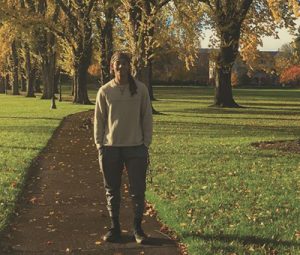 After a walk across the United States and an epic 48-hour experience in Grand Canyon National Park, junior Josh Lewis knew he had to study forestry.
After a walk across the United States and an epic 48-hour experience in Grand Canyon National Park, junior Josh Lewis knew he had to study forestry.
The park rangers took care of him and gave him advice during his hike through the canyon.
“I hiked from north to south, and due to snow, I had to hike backwards and go back around,” Lewis explains.
But his spirit wasn’t deterred.
“I tried to have the mindset that this is one of the most beautiful places I’ve been, and I get to see it twice,” Lewis says. “And, thanks to the rangers, I realized my dream of working on and managing public lands.”
Lewis was born in the Pacific Northwest and spent time in rural Idaho as a child, before his family moved on to bigger cities.
“I think starting out in nature really shapes you,” he says. “I’ve worked a lot of different kinds of jobs, and after a while, they all get old. I’ve been studying forestry for about three years now, and it still excites me because of the connection to the natural landscape.”
Lewis now calls Maui home, and first studied at the University of Hawai‘i, but took a break to complete his long walk when he realized he wasn’t working toward a particular goal. Since arriving at Oregon State, he’s kept his head in his books and focused on his classes. He says that since entering professional school, he’s hit a groove, and is enjoying his upper-level forestry classes.
He marks field school as one of the best Oregon State experiences so far.
“It felt like class, but it was really self-driven,” Lewis says. “I needed a lot of time to finish some of the exercises we did because going in, I wasn’t completely confident in my forestry skills.”
Field school orients students to the professional forestry program and reinforces skills they’ve learned in the classroom by allowing students to practice in a real-world setting.
Lewis says one of the benefits of field school was getting to know his fellow classmates.
“During field school, we spent all day in the woods together and lived together at night,” he says. “It was an A-plus experience.”
Lewis’s goal is to work at Haleakala¯ National Park on Maui, but he says staying put in Oregon is a great backup plan.
“I love it here,” he says. “It’s beautiful, and it’s not really that far from the islands.”
He encourages anyone interested in the outdoors to consider studying forestry at Oregon State.
“I’m earning marketable skills in an industry that will allow me to work outside,” Lewis says. “My experience has been seamless. Everyone is friendly, and I love the atmosphere of my classes.”
A version of this story appeared in the spring 2019 issue of Focus on Forestry, the alumni magazine of the Oregon State University College of Forestry. Learn more about our undergraduate programs here.

 When Bill and Marion Collins moved onto 160 acres near Gold Hill in Jackson County, they had no idea what to do with their land or how to manage it.
When Bill and Marion Collins moved onto 160 acres near Gold Hill in Jackson County, they had no idea what to do with their land or how to manage it.



 On May 14, 2019, the Oregon State University College of Forestry celebrated the grand opening of the A. A. “Red” Emmerson Advanced Wood Products Laboratory. Sierra Pacific Industries, founded by Emmerson and his father, R. H. “Curly” Emmerson, contributed the lead gift of $6 million toward building the facility in October 2015. The new lab adds 15,000 square-feet of structural testing space to the college, which already boasts some of the best technical research facilities in the nation.
On May 14, 2019, the Oregon State University College of Forestry celebrated the grand opening of the A. A. “Red” Emmerson Advanced Wood Products Laboratory. Sierra Pacific Industries, founded by Emmerson and his father, R. H. “Curly” Emmerson, contributed the lead gift of $6 million toward building the facility in October 2015. The new lab adds 15,000 square-feet of structural testing space to the college, which already boasts some of the best technical research facilities in the nation.













